Games
PCB
Archive
Chip
Archive
Cart/Box
Scans
Articles
Peripherals
Prototypes
Unreleased
Games
Rarities
Homebrew
Emulation
Links
Email: snes_central@yahoo.ca
Release of the Super NESRelease of the Super NES |
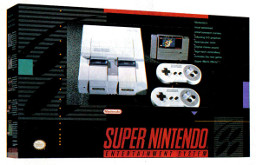 The Super NES was released in August 1991. To celebrate the 25th anniversary of the release of the SNES, I have investigated the actual release date of the the system in the US and Canada, and make an educated guess on what games can be considered to be "launch" games. Credit for the magazine scans goes to Retromags By:
Evan G
|
 |
| Super Mario World made the cover of many contemporary video game magazines |
August 2016 represents the 25th anniversary of the release of the Super NES in North America. Though not quite as hard to investigate as the release of the NES, it wasn't released along with a huge marketing blitz for a specific day like modern console releases. This article gives an overview of the launch of the SNES in North America. The nation-wide release date of the console was September 9th, 1991, but it was available earlier in California, possibly as early as August 21st, 1991.
I have to admit, as a nine year old boy living in rural Canada, the release of the SNES hardly warranted a mention. As a result I can't give a first hand account of the launch. I doubt it even got a mention in the Sears Christmas Wish Book catalogue, which would have been the main source for knowing about upcoming games at that time. I got a NES for Christmas in 1989, and probably was enjoying games like Super Mario Bros 3 and Teenage Mutant Ninja Turtles 2 when the SNES was released. It probably did not help that the system was not launched until late 1991 in Canada (see below for more details), and with little fanfare. I got my SNES for Christmas 1992, getting hyped after picking up some second hand Nintendo Power magazines that covered the launch. I think I even got a hint book called Play Action Strategies: Super Nintendo before getting the system (such is my memories of this guide book that the first games added to this site were the order they appeared in this guide).
Lead up to the release of the Super NES
The Super NES was first announced at the January 1991 CES, two months after the Super Famicom was available in Japan. The system was not shown off at that point. They gave a tentative release date of "September 1991". This is when the system officially was given the name "Super NES". Prior to that, it was known using the code-name "SFX" or "NES-SFX", which means Nintendo Entertainment System - Special Effects. The EGM article below that states this also speculated that the system could have launched as a peripheral to the NES rather than as a separate system, but obviously that didn't happen.
 |
| Speculation on the Super NES in the October 1990 issue of EGM |
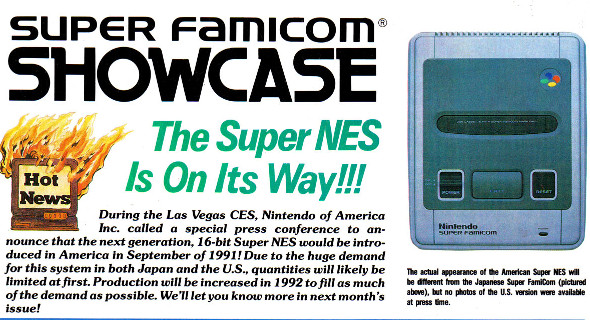 |
| Announcement of the Super NES at Winter 1991 CES. From Nintendo Power, February 1991 |
 |
| Note about a press conference at the Winter 1991 CES. From Nintendo Power, March 1991 |
Although one might have expected the official reveal of the console to have been at the Summer 1991 CES (held June 1-4), it actually was first revealed in the June 1991 issue of Nintendo Power. The SNES was a big part of the Summer CES. Someone uploaded some video coverage of the event, which reveals that the design system, logo and games were complete at that time. Even at the Summer CES, an exact launch date was not given, though the Quartermann rumour list in the August 1991 issue of EGM states they intended to have a September 1st release date. This date may have actually been given out prior to the CES, as it was noted in an article in the May 1st edition of the Tampa Bay Times:
Nintendo, the leader in the home video game business, plans to introduce on June 1 a new game deck that will make obsolete the Nintendo machines now in 28-million American homes.
....
Rumored to be on the way for almost 18 months, the 16-bit Super Nintendo Entertainment System - Super NES in kid lingo - will be priced at $190 for the basic game system. The old 8-bit game deck cost $99.
It's not yet known how much the game cartridges for the new deck will cost. But the cartridges from the old machine, which cost $35 to $50 apiece, won't work on the new one.
....
Super Nintendo will be unveiled June 1 in Chicago at the summer Consumer Electronics Show. Until then, no information is forthcoming about what the new game deck looks like or how many software games will be immediately available to play on it.
But Gervino of Toy and Hobby World said Nintendo will include its first American 16-bit game in the $190 start-up package - Super Mario Brothers 4, a bigger, better continuation of the company's immensely popular Super Mario Brothers game series.
"That's a huge attraction for kids," Gervino said. "(Parents) will just have to suck it up and let it happen."
Nintendo's initial goal is to sell 2-million 16-bit systems in America between Sept. 1, when the game is expected to reach retail shelves, and the end of the year.
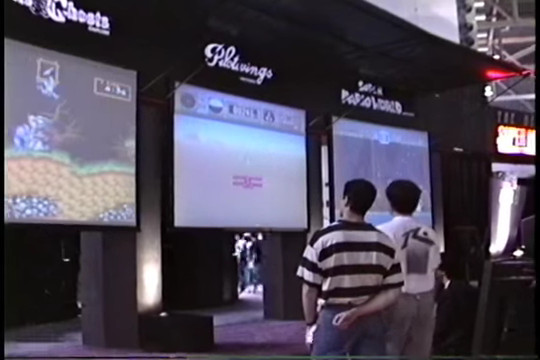 |
| Nintendo's booth at the Summer 1991 CES. |
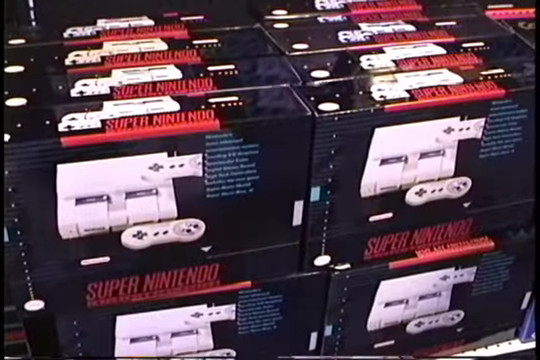 |
| The box design was nearly finished by the start of June 1991 |
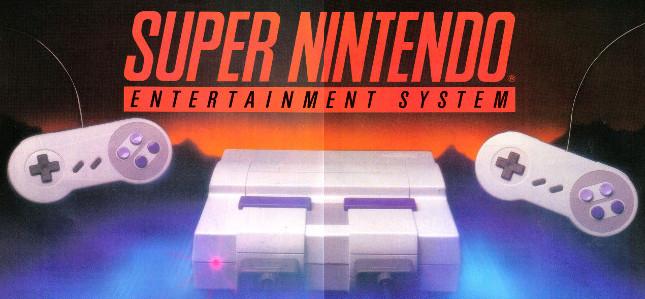 |
| Unveiled Super NES in the June 1991 issue of Nintendo Power |
United States release date
Unlike the release of the NES, it was relatively easy to track down the exactly when the launch of the Super NES happened. This article from the September 10, 1991 edition of the New York Times states it precisely. The nation-wide launch of the Super NES happened on September 9, 1991, with a retail price of $199.95, with a Super Mario World pack-in. They also launched with Pilotwings and F-Zero, with carts costing $49.95. Nintendo Power, in the October 1991 issue also gives a September 1991 release time.
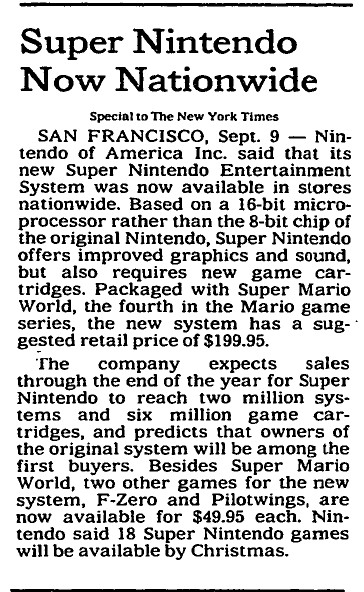 |
| New York Times article, September 10, 1991 |
However, unlike modern day console releases, there wasn't an exact launch date everywhere. The Super NES came out about three weeks earlier than the nation-wide launch date in California. From the Orange County Register (Santa Ana, California), August 27, 1991:
Last weekend, months after video-game addicts started calling, Dave Adams finally was able to sell them what they craved: Super Nintendo.
Adams, manager of Babbages in South Coast Plaza, got 32 of the $199.95 systems Friday. By Monday afternoon he had five left.
"Everybody that calls up (to see if they're in stock) seems to hop in their car and come down to get one," he said. "I expected to blow them all out the first day."
....
At Software Etc. in the Mall of Orange, manager Don Leon was counting the minutes until his shipment of Super Nintendos arrived. He had ordered eight and already had reservations for most of them. He takes reservations only for particularly hot items, he said.
Super Nintendo began showing up in Southern California stores Wednesday (note, this would mean August 21, 1991), nearly three weeks before the official Sept. 9 release date.
"The people that really wanted to get it right away knew it was out," Adams said. "People have been calling for months on this thing."
The Toys R Us store in Cerritos got 80 on Wednesday and was down to a handful Monday afternoon, a store spokeswoman said.
Answering players' questions Q. Where is the 16-bit Super Nintendo available? A. Until the official nationwide release Sept. 9, availability will be limited. Toys R Us and some smaller distributors had it early. Nintendo says Kmart, Target and FAO Schwarz will have it.
This indicates that the Super NES may have been available as early as August 21, 1991. It is uncertain why it came out early in California, except that this might be where the shipments from Japan were unloaded. There was also a USENET post from August 26th 1991, which states a Toys-R-Us store was selling the system on August 22nd (the guy also states he bought his on the 23nd):
The SNES made it to Toys-R-Us here the afternoon of 8-22-91. They received about a dozen of them, and they appear to be going fast. I haven't found them anywhere else yet. The package price is $199.99, and includes everything needed to us it (control unit, power adapter, RF adapter, AV cable, 2 controllers ) plus Super Mario World. There were also 2 other games available. Pilot Wings, and F-Zero, both for $49.99.
I bought mine friday, 8-23 (the 4th one they'd sold ), along with F-zero.
The November 1991 issue of EGM states the release date was August 23rd, 1991:
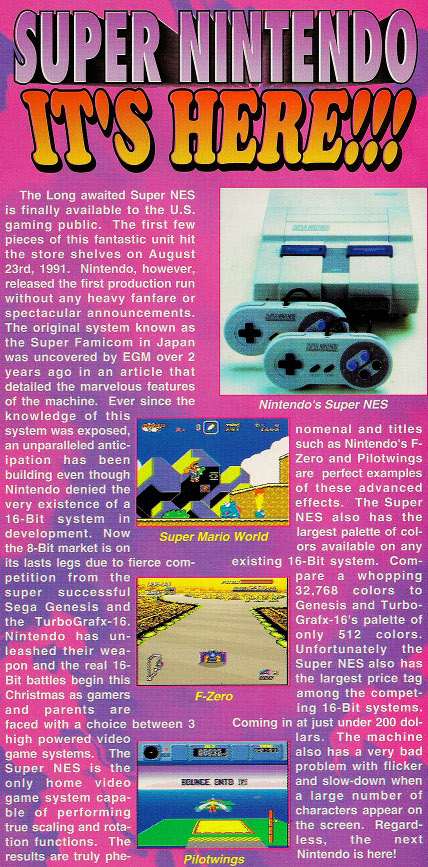 |
| EGM article on the release of the SNES, November 1991 |
An article in the August 30th edition of the Orlando Sentinel seems to indicate that the system may have been available in Florida/Georgia (the authors were based out of Atlanta) by the end of August. However, given that the authors' preview some games that were probably not released until after launch, this may be a description of their experiences at the Summer CES.
It's here - the long-awaited Super Nintendo Entertainment System, 16 bits of playing power at your fingertips.
Not that 16-bitters are anything new. Sega's Genesis and NEC's TurboGrafx-16 have been around for a couple of years. But the Nintendo name on a system with twice the power of the original has had everyone excited.
And with good reason: The Super NES is everything you've heard. If you've seen or played a Genesis or a Turbo, you won't be stunned by the new NES. On the other hand, if all you've played is 8-bit games, welcome to the future.
As good as some 8-bit games are, there's simply no way they can match 16-bitters. The colors, graphics, sound, action and play control of the big systems are so much better that it's often hard to tell the difference between home and arcade games.
As you might expect, you pay for the extra 8 bits. The Super NES costs a little more than $200 (more than twice the price of the original), Genesis clocks in at about $50 less, and recent price cuts have put the Turbo-16 at $99.
The Super NES might be the best of the 16-bit systems. We say "might" because we haven't had it long enough, or seen enough games, to know for sure. We do know it's hot, though. The graphics, color and sound look pretty much like what Genesis brings to the screen, which is saying a lot. But the Super NES gets the nod for play control. Where the Genesis controller has A, B, C and Start buttons, the Super NES sports A, B, X, Y, Start and Select buttons on the face and Left and Right buttons on the front side. Obviously, that increases your options. It also gives game programmers more room to move when they're dreaming up new titles.
Looking back to my time on the Digital Press message board, there was a lot of debate on when the exact launch date. In all likelihood, retailers started to sell it as soon as they got stock, which appears to be between August 21st and August 23rd in California. Looking at rec.game.video, there were several posts from August that confirm a late August release. An article by 1up for the 15th anniversary state an earlier date of August 13, 1991, but they don't state where that date comes from. I'm guessing someone posted it by mistake on Wikipedia, so I looked into when this date was added to the Super NES article. My investigation of that shows that a date of August 14th was added by an anonymous user with a Canadian IP on October 30th 2005, and almost immediately changed by someone else to the 13th. No justification was given for these edits, and I would assume this is where the 1up article got its date from. There is an anecdote on the Digital Press thread of someone getting it on the 13th, but at this point I would say that it is just hearsay.
Release in Canada
When the Super NES was released, Nintendo obviously expected brisk sales. Due to this, they clearly did not believe they would be able to release the system in Canada until 1992:
 |
| From the Nintendo Power FAQ on the SNES in the October 1991 issue. |
The vice-president of Nintendo of Canada, at the Summer CES, pretty much says they didn't want to cut into the sales of the NES, which had not been available as long in Canada. From the June 4th, 1991 edition of the Ottawa Citizen:
...
The S-NES, which has been sold in Japan for nine months, was unveiled to buyers at Chicago's Summer Consumer Electronics Show.
It will be available in the U.S. by September, but not in Canada until 1992.
Peter MacDougall, vice-president and general manager of Nintendo of Canada Ltd., said the company doesn't want to confuse Canadian consumers into thinking it's time to trade in that old eight-bit system _ and stop buying up eight-bit software.
''Because the eight-bit system hasn't been on the Canadian market too long, (Canadians) haven't fully explored many interesting and exciting eight-bit games,'' MacDougall said. ''If they quickly switched, they would never explore it. Now they can fully appreciate what those games can do.''
....
However, there were two factors that probably led them to release it in Canada early. First was that the initial sales were underwhelming in the US. In 1991, America was in the midst of a recession. There were plenty of parents who questioned why there was a need to spend money on a new system. From an article dating to September 16, 1991 from the Seattle Times:
The $700 million question is not whether Mario will defeat Bowser's Krazy Koopa Kritters.
That depends on players of "Super Mario World," the game bundled with the new Super Nintendo Entertainment System.
No, the $700 million question is whether kids will demand their parents buy the new $200 video-game player made by Nintendo of America.
Big money rides on what kids want. Nintendo figures sales this year of Super Nintendo and its software will hit $700 million, making Nintendo again the biggest moneymaker of Christmas toys. Nintendo predicts sales of Super Nintendo will at least double next year.
Super Nintendo is now on sale at such outlets as Toys R Us and Lionel Playworld. A nationwide advertising blitz has started, to be followed by an album of Nintendo-inspired music by Crosby, Stills & Nash, Alias, Sheena Easton and other stars, and a Mario movie next year. Danny DeVito is expected to star as Mario, the digitized Italian plumber who dodges electronic villains.
Because the old and new Nintendo machines are not compatible, games for the old system don't work on the Super Nintendo. That means Mom and Dad have to buy another set of games at $50 each.
Robert Kleiberg, an analyst with the stock brokerage Piper, Jaffray & Hopwood, says parents will split into two groups: those who believe they have spent enough on Nintendo and that their "kids' brains are sufficiently fried," and parents who want to see their children entertained. Since kids have a lot to say about what they get as presents, Kleiber expects Nintendo will have a "strong Christmas."
But is Nintendo overestimating kids' enthusiasm for the new machine? And parents' willingness to pay $200 for it?
The Nintendo craze does have limits. The Software Industry Bulletin reported that Nintendo's sales have slowed during a period of intensifying competition. The bulletin said the video-game market faces a clutter of new technologies and a wobbly national economy. Kleiber doubts that the Super Nintendo will sell strongly beyond a few years.
The other factor, of course, was the release of Sonic the Hedgehog on the Sega Genesis. Also aiding Sega was the fact that the system was $50 cheaper and had a larger library. From the December 18th 1991 edition of the Austin American Statesman:
...
On the national level, Sears, Roebuck and Co. said it was enjoying good sales of big-screen televisions selling for $2,000. Sears also reported strong sales for Sega and its arch-rival, the new Super Nintendo system. "Both are doing exceptionally well," Sears spokeswoman Marcy Grossman said.
A big unknown before the start of the holiday season was how well video systems would fare in the soft economy, especially the Super Nintendo, which retails for $200. Another question was how the recently launched Super Nintendo would do against its cheaper and more established competitor, Sega.
"Super Nintendo isn't doing that great," said the Electronic Boutique's Carlo, who found customers leaning toward Sega because it is a faster machine and has more games available. Carlo said his store, which is part of a national chain, has already sold out one shipment of Sega units.
Super Nintendo's price tag may be a stumbling block for some consumers.
"Fifty dollars is a lot in this economy," said one national retailer, who spoke on condition his name not be used.
"Sega is outselling Super Nintendo . . ." he said. "By the end of Christmas, there won't be a piece around."
Due to these factors, Nintendo decided to release the Super NES in Canada before the Christmas holidays, specifically December 2nd, 1991. They even launched it at a relatively reduced price, probably to stave off the competition from Sega. From the December 3rd 1991 edition of the Ottawa Citizen:
Aiming squarely at Christmas sales, Nintendo of Canada released its much-vaunted ''Super'' Nintendo system in Canada Monday.
The 16-bit Super NES system, available in Japan for a number of years and introduced earlier this year in the United States, is being sold at a suggested retail price of $219, undercutting U.S. prices.
The Canadian firm's vice president and general manager, Peter MacDougall, said Nintendo is aiming for 75 per cent of the 16-bit market within a year. He said sales of 325,000 units are projected next year, along with sales of 700,000 games and 155,000 accessory units.
Since its introduction in the U.S., more than 2.2 million systems have been sold, MacDougall said.
The firm is targeting a core group of Nintendo enthusiasts in Canada -- boys of eight to 14 -- with the new system which offers players enhanced graphics, multiple scrolling screens, digital stereo sound and 3D capabilities.
Further, it appears that Nintendo also wanted to combat cross-border shopping, according to an article in the December 14th edition of the Windsor Star. However, the quote from the editor of Players' Strategy Guide to Nintendo Games rightly says that it was also to try and prevent Sega from gaining a foothold in Canada.
Super Nintendo arrived in Canada several months ahead of schedule.
"It really was an overwhelming response from our players," says Nintendo Canada vice-president Peter MacDougall. "Even we underestimated it."
Vancouver-based Nintendo had not planned to release it until spring, more than six months after its Labor Day release in the United States.
But so many Canadians were flocking across the border to buy Super Nintendo - at prices up to $400, says MacDougall - that the company moved up the Canadian launch.
Nintendo set the Canadian price at $219, about $100 more than the old system and a few dollars below the equivalent U.S. retail price for Super Nintendo.
"We've been very sensitive to the whole cross-border shopping issue," says MacDougall.
Nintendo figures there are 2.5 million old Nintendo systems in Canada, compared with 30 million in the United States. It has 85 per cent of the video game market in North America and plans to keep issuing new games for the old system.
MacDougall thinks Nintendo can get 75 per cent of North America's 16-bit game market with Super Nintendo.
But as in Super Mario World, the new system's flagship game, there are hidden threats.
Nintendo wasn't first out of the blocks with a 16-bit system. NEC, the Japanese electronics giant, has marketed its Turbo Grafix system for two years. The Sega Genesis system, which sells for about $50 less than Super Nintendo, offers more than 100 games versus Super Nintendo's dozen initial offerings in Canada.
THE SEGA SYSTEM has good word-of-mouth among game buffs, says Selby Bateman, executive editor of Players' Strategy Guide to Nintendo Games, a U.S.-based magazine with 300,000 circulation. That loyalty might eat into sales projections for Super Nintendo.
"I think they probably won't sell quite as many as they think they would," says Bateman.
In summary, Nintendo had a disappointing start to its release of the Super NES in North America. It was hurt by a weak economy and competition from the Sega Genesis. The SNES would remain behind the Genesis in total sales until late 1994, when the release of Donkey Kong Country put it over the top.
Launch titles
Much like the system itself, there were no specific release dates for games, and they would have hit the shelves as soon as they were shipped to retailers. We can, of course, say that Super Mario World was released simultaneously with the system, as it was a pack-in. F-Zero and Pilotwings were also released on launch date. Several games came shortly afterwards, but their release dates are unlikely to be determined any more precisely than by month.
As I host a large PCB archive, I have the ability to come up with an objective estimate of when games might have come out. About 80-90% of ROM chips come with a manufacturing date stamp, which gives the week number of when it was produced. All games in 1991 were made in Japan, so the timing of release would probably be at least a week or two after the chips were made, to give time for shipping. I specifically have put out a call to try and find the oldest Super Mario World. The oldest chip identified so far has a stamp of 9132, which is the first full week of August, two weeks before the SNES started hitting the shelves. I looked through my archives to find all games that were manufactured by the end of August 1991 (9134), and this is my list:
- Pilotwings - 9128
- F-Zero - 9129
- Gradius - 9131
- Populous - 9131
- Super Bases Loaded - 9131
- Super R-Type - 9131
- UN Squadron - 9131
- Super Mario World - 9132
- Drakkhen - 9134
- HAL's Hole In One Golf - 9134
- SimCity - 9134
All of these games could conceivably have come out either at the official nation-wide launch of September 9th 1991, or soon after. I would regard all of the above games as "launch" titles. Note that my PCB archive is hardly comprehensive, so it is possible that other games are in this window. I will point out that the oldest game I have is Pilotwings, but I would imagine the manufacturing of Super Mario World would have started by the time Pilotwings did. This does not include other games that came out near launch, such as Final Fight, Final Fantasy II and Super Castlevania IV. The oldest manufacturing dates for these games would have put them outside of the launch week by at least a few weeks.
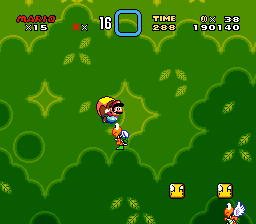 |  |
| Super Mario World | F-Zero |
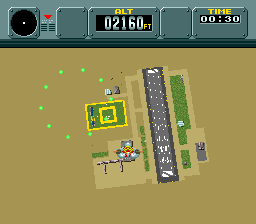 |  |
| Pilotwings | Super Bases Loaded |
 |  |
| Super R-Type | Populous |
 |  |
| Gradius III | Drakkhen |
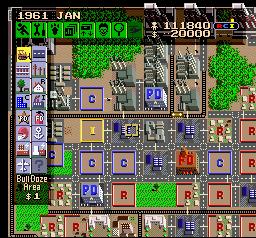 |  |
| SimCity | HAL's Hole In One Golf |
 |
| U.N. Squadron |
So in total there were at least 11 games that came out in the launch window of the SNES. They include three shooters, a racing game, three simulations, two sports games, one platformer and one RPG. The launch lineup was very much a display of the capabilities of Mode 7 (F-Zero, Pilotwings and Drakkhen use it extensively). Super Bases Loaded was also the first game to use the Super NES hi-resolution mode, although I would argue this is one of the most bare-bones baseball games for the system (save maybe Relief Pitcher). Drakkhen was the first RPG for the system, but was soon overshadowed by Final Fantasy II, which came out soon after launch. SimCity and Populous were conversions of popular PC games, which at the time was a big deal since PCs were not ubiquitous like they are now. Gradius III was one of the biggest shooters to come out, but the slowdown problems that plagued it did not make it enduring to the Genesis crowd.
Overall, a launch lineup containing Super Mario World, F-Zero, SimCity and Pilotwings was likely enough to satisfy early adopters, but not enough to blow the Genesis away. In hindsight, if crushing Sega were the goal, they would have released the system before Sonic The Hedgehog came out (which was in June 1991). Super Mario World, although an incredibly deep platformer with branching paths, could not compete with the the coolness of Sonic. Nor could the relatively slow processor in the SNES, which led early games like Super Ghouls 'N Ghosts and Gradius III to have major slowdown problems.
It wasn't until Street Fighter II came out that the SNES really started to hold its own in the console wars. We have to look at the launch of the SNES as an incremental step above the NES, but Nintendo was too hesitant in the face of their first real competition in the console market. Even so, the SNES launched with a solid lineup of games, with titles like Super Mario World, F-Zero and SimCity still holding up to this day.
Bibliography
- Nintendo Power, Pak Watch - Super Famicom Showcase (announcement at the Winter 1991 CES), Publication date: February 1991, Volume: 21, Pages: 94
- Nintendo Power, Pak Watch - Winter Consumer Electronics Show (states the Super NES was not playable and only shown behind closed doors), Publication date: March 1991, Volume: 22, Pages: 95
- Nintendo Power, Player's Poll Contest (win a Super Nintendo system and a trip to Redmond Washington), Publication date: July 1991, Volume: 26, Pages: 82-83
- Nintendo Power, Super NES Q&A: Answers to Your Top 10 Questions, Publication date: October 1991, Volume: 29, Pages: 70-71
- Thread on Digital Press discussing the 15th anniversary of the SNES (link)
- Thread on Digital Press on the release date of the SNES (link)
- Sears Wish Book Advertisement for the Super NES in 1991 (link)